| Srl | Item |
| 1 |
ID:
145392


|
|
|
| 2 |
ID:
145393
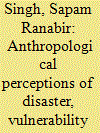

|
|
|
|
|
| Summary/Abstract |
A structured analysis of social inequalities related to hazards allows for a clarification and redefinition of the involved citizenship rights and their implications for the trust of citizens in public institutions. The concerned individuals, social groups and communities must participate in the knowledge production process about the territory and in the mapping of social vulnerability.
|
|
|
|
|
|
|
|
|
|
|
|
|
|
|
|
| 3 |
ID:
145378
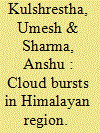

|
|
|
|
|
| Summary/Abstract |
The Himalayan range is the youngest with highly active mountains on the earth. These mountains have assumed a greater importance by regulating the weather of northern Indian subcontinent since times immemorial (Kumar et al., 2010). However, the inherent geological and anthropogenic influences has increased its susceptibility of these ranges to the hazards of landslides, failure of natural dams, glacial lakes outburst, flash flood, debris flows and cloud bursts (Kumar et al., 2010).
|
|
|
|
|
|
|
|
|
|
|
|
|
|
|
|
| 4 |
ID:
145384
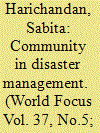

|
|
|
|
|
| Summary/Abstract |
Major disasters overload the capability of first responders like community. Countries must prepare for and adapt to the impacts of disaster. Linking short-term disaster preparedness to long-term strategies for adaptation to profound impact would serve the purpose better. Addressing to the increased vulnerability of people of the community and making them empowered, prepared and vigilant may prove to be the panaceas.
|
|
|
|
|
|
|
|
|
|
|
|
|
|
|
|
| 5 |
ID:
145396


|
|
|
|
|
| Summary/Abstract |
Disasters destroy lives and livelihoods around the world. Thus science and technology is already helping to save lives and livelihoods in some instances. For disaster risk reduction, science is considered in its widest sense to include the natural, environmental, social, economic, health and engineering sciences.
|
|
|
|
|
|
|
|
|
|
|
|
|
|
|
|
| 6 |
ID:
145397
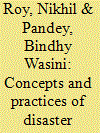

|
|
|
|
|
| Summary/Abstract |
From the above discussions it is clear that even though hazards are unavoidable, disasters are preventable. This has created the discipline and the practise of Disaster Management, wherein, the risk of disaster and the vulnerability of people to disaster is reduced. An example of how disaster management reduce the loss to life and property is the case of the coastal areas of Andhra Pradesh and Orissa in India.
|
|
|
|
|
|
|
|
|
|
|
|
|
|
|
|
| 7 |
ID:
145395


|
|
|
|
|
| Summary/Abstract |
The impact of disaster is no more new phenomena now days. It can cause anytime and anywhere, so the best way to solve this problem and reduce the loss of life and property is to stay alert and active all the time. Human being cannot stop disaster but minimise its impact by the use of technology.
|
|
|
|
|
|
|
|
|
|
|
|
|
|
|
|
| 8 |
ID:
145381
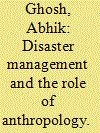

|
|
|
|
|
| Summary/Abstract |
Disaster management can only be as good as the subject and the personnel that are involved in the process. Without human beings as support groups, an anthropological model is of no practical use. Perhaps it is this grounded nature of its reality that gives its tool-kit the added sharpness, better and more skillful at its job.
|
|
|
|
|
|
|
|
|
|
|
|
|
|
|
|
| 9 |
ID:
145380
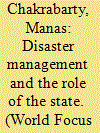

|
|
|
|
|
| Summary/Abstract |
Natural disasters hit at all in the society without any discrimination, rich and poor. But in reality, it is the poor who are the worst sufferers. One of the most important tasks before us is to introduce a culture of prevention in disaster managers and all communities at all levels. The culture must be disseminated so that all people in the society can become alert and become aware so that they can take some preventive measures in case of an emergency or before the disaster strikes. In this regard, early warning and conscious developmental planning are key elements to preventive planning regarding disaster. In India, now we experience a paradigm shift from post disaster response mechanism to pre disaster prevention, preparedness and mitigation strategy.
|
|
|
|
|
|
|
|
|
|
|
|
|
|
|
|
| 10 |
ID:
145375
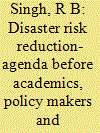

|
|
|
|
|
| Summary/Abstract |
According to recent World Disaster Reports the percentage of occurrences of flood is highest (43 per cent) with 3062 occurrences of the total disasters during 1995-2015 followed by storms (28 per cent) with 2018 occurrences. The volcanic activities have the lowest occurrence of only 111 events (2 per cent). Others include earthquake (8 per cent), extreme temperature (6 per cent), landslide (5 per cent), drought (5 per cent) and wildfire (4 per cent). According to EM-DAT CRED the hydrological and meteorological disasters are causing loss of about USD 250 million every year.
|
|
|
|
|
|
|
|
|
|
|
|
|
|
|
|
| 11 |
ID:
145394
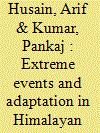

|
|
|
|
|
| Summary/Abstract |
Climate change is one of the most complex and difficult challenges for the Himalayan countries. Scientific data to monitor climate and environment change are lacking in the Himalayas region. For example IPCC has identified Hindu-kush Himalayas region as the data deficient. Long-term research and comprehensive data are needed to plan adaptation and mitigation program to deal with future changes.
|
|
|
|
|
|
|
|
|
|
|
|
|
|
|
|
| 12 |
ID:
145376
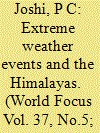

|
|
|
|
|
| Summary/Abstract |
Kedarnath and Kashmir floods teach us some very important lessons which may go a long way in management of flood disasters. The first lesson is that the climate change is a reality and we need to prepare for more frequent and severe hydrometeorological hazards in the coming years.
|
|
|
|
|
|
|
|
|
|
|
|
|
|
|
|
| 13 |
ID:
145388
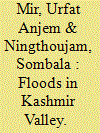

|
|
|
|
|
| Summary/Abstract |
Drury and Oslon (1997, 1998) found a relationship between natural disasters and political unrest and the variables such as insufficient and inequitable government response and the severity of the disaster. It has been further found in few studies conducted by various scholars that vulnerabilities created by natural disasters can be exploited by rebel groups; droughts increase civil war in Africa and that natural disasters increase the risk of violent civil conflict in the short and medium term in low and middle income countries.
|
|
|
|
|
|
|
|
|
|
|
|
|
|
|
|
| 14 |
ID:
145398
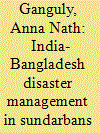

|
|
|
|
|
| Summary/Abstract |
Climate change has become critical to issues pertaining to human security, resource availability and accessibility, and ecological stability of a nation, since hydro-climatic hazards like droughts, floods, earthquakes pose threats to human life and exacerbate socio, economic and political tensions.
|
|
|
|
|
|
|
|
|
|
|
|
|
|
|
|
| 15 |
ID:
145390


|
|
|
|
|
| Summary/Abstract |
Ladakh, the high altitude desert, normally used to receive lots of snow fall in winter and very less rains in summer. Most of the villages in Ladakh depend on the snow and glaciers melted water for their agricultures and drinking. But the victims shared that it slowly was changing and less snow fall in winter and more rains in summer were being experienced.
|
|
|
|
|
|
|
|
|
|
|
|
|
|
|
|
| 16 |
ID:
145391
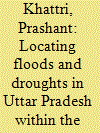

|
|
|
|
|
| Summary/Abstract |
The Indian scenario of disaster management is largely guided by two documents viz- the Disaster Management Act (DMA), 2005 and the National Policy on Disaster Management (NPDM), 2009. As recently as on February 26, 2013, a multi-stakeholder National Platform for Disaster Risk Reduction (NPDRR) has been constituted by the Government which is headed by the Union Home Minister and which has a tenure of not more than five years, after which a review of its constitution shall take place.
|
|
|
|
|
|
|
|
|
|
|
|
|
|
|
|
| 17 |
ID:
145387


|
|
|
|
|
| Summary/Abstract |
Sociologists and Anthropologists engage in researches predominantly emerging from the developing world which position them to comment on issues related to disasters owing tohigh vulnerability of the regionto natural disasters (Henry, 2005). The developing world experiences three times the disaster related casualties and losses in the developed parts of the world (UNDRO, 1984).
|
|
|
|
|
|
|
|
|
|
|
|
|
|
|
|
| 18 |
ID:
145386


|
|
|
|
|
| Summary/Abstract |
Carbon markets are a reality and forms an important component of the Paris Agreement. However, the uncapped nature of the Paris Agreement means that the new market mechanism framework will need to be able to accommodate flows in many directions, unlike North to South flow under Kyoto Protocol. The eventual goal remains the globally linked market which though in principle appears complicated, is actually a better and a feasible idea as it expands the pool of participants and can broaden emission reduction opportunities and reduce volatility.
|
|
|
|
|
|
|
|
|
|
|
|
|
|
|
|
| 19 |
ID:
145382
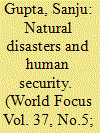

|
|
|
|
|
| Summary/Abstract |
The toll of human death and property damage has dramatically increased, far outstripping the coping capacities of the local, national, and even global assistance efforts. Natural disasters thus elicit taking a fresh look at the definition of security itself. Disasters can provide a measure of the preparedness and integrity of the affected society, showing both the adherence by the people to sound building and land use codes and the avoidance by the government of corruption and ineptitude.
|
|
|
|
|
|
|
|
|
|
|
|
|
|
|
|
| 20 |
ID:
145383
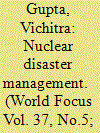

|
|
|
|
|
| Summary/Abstract |
Nuclear energy, though a viable source of generating electric power, needs to be used carefully. Any nuclear disaster not only affects the health and lives of the population but also leads to decline of the area politically and economically. Fukushima and Chernobyl incidents have issued serious warnings to India that when Japan, a country better-equipped and more technically advanced than India could suffer such a disaster then India needs to review its nuclear safety norms, nuclear establishments and plans for disaster mitigation.
|
|
|
|
|
|
|
|
|
|
|
|
|
|
|
|